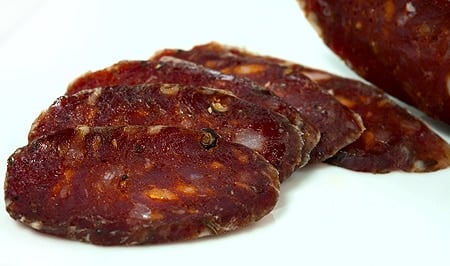
I am a big fan of easy-to-eat salami. I grew up eating Slim Jims, and thin salami you can carry along with you are a real treat on the road or in the field; we love to eat them in the duck blind in winter.
As far as salami goes, this one is pretty easy. It uses standard hog casings instead of beef casings, which can be tough to find. The wider beef casings are more challenging to cure, too. These thinner salami can cure in as little as 2 weeks, although a month is better.
The flavorings here make a powerfully spiced salami. You can pare them back if you want, or change them any way you wish — only don’t mess with the salt, curing salt, dextrose or sugar, and black pepper.
You also will need a few things before you even start:
- A humidifier, or a place where the humidity can reach 85 percent.
- A place to hang your sausages in this humid environment.
- A place to hang your sausages after the initial ferment, preferably a place with humidity about 80 percent and about 55°F.
- Hog casings, which are available at any good supermarket (ask the butcher) or in a butcher’s shop.
This recipe makes 5 pounds, or about 20-22 eight-inch links
- 4 pounds pork or wild boar
- 1 pound pork fat
- 38 grams (about 3 tablespoons) kosher salt
- 20 grams (2 tablespoons) sugar or dextrose
- 6 grams (about a teaspoon) Instacure No. 2
- 1 tablespoon garlic powder
- 2 teaspoons caraway seed
- 1 tablespoon ground coriander seed
- 2 tablespoons ground black pepper
- 1 teaspoon ground chile
- 3 tablespoons sweet paprika
- 20 grams (about 2 tablespoons) starter culture T-SPX
- 1/4 cup distilled water
- 1/4 cup red wine
- Chill the meat and fat in the freezer for about an hour. You want it close to frozen, even a little crispy cold.
- Chop the meat and fat into 1-inch chunks. Remove as much silverskin and gristle as you can from the pork.
- Put about 10 feet of hog casings into some warm water and set aside.
- Mix all the spices, salt, curing salt and sugar with the meat and fat. Chill for 1 hour in the fridge.
- Grind through the coarse die on your grinder. If you are using trim from a boar — meaning there’s a lot of silverskin, etc — you’ll need to grind the sausage finer. Grind first through the coarse die, then again through the fine die. If you need to double-grind, chill the meat in the freezer between grindings for 15 to 20 minutes. Clean up the grinder while the meat is chilling. When you finish cleaning it, submerge everything in ice water to quickly cool it down.
- Meanwhile, run warm water through your hog casings. This flushes them, and will show you any leaks in the casings. Set them back in the warm water when you’re done.
- Take the temperature of the meat: If it is warmer than 40°F, put it back in the fridge for 30 minutes and check again.
- When the pork is good and cold, get your starter culture ready. Gently mix the starter culture with the distilled water and let it sit for 5 minutes.
- Take out the meat and put it in a mixer bowl with the heavy paddle attachment. Add the starter culture and wine, then mix everything on the lowest setting for 60 to 90 seconds. You will see the meat change texture. You are looking for a good bind, where the meat is beginning to stick to itself.
- Put the meat into your sausage stuffer and stuff it into the hog casings. Twist off into links of about 8 inches. Tie off each link with kitchen twine.
- Hang the links on a drying rack — a wooden clothes drying rack is excellent for this — and find a needle. Heat the tip of the needle over a flame until it glows; this sterilizes it. Prick the casing anywhere you see air pockets.
- Now you need to ferment the sausage. You will want to tent the hanging sausages with black plastic from some garbage bags, or some other plastic sheeting. If you have one, put a humidifier under the sausages. You really want them to stay moist.
- Let the sausages hang for at least 24 hours, and up to 48 hours. Every 6 to 8 hours, spritz them with a spray mister to keep them moist. This is the fermentation stage, the stage where the starter culture you are using defeats any bad bacteria in the sausage.
- When the sausages are ready, hang them in your drying chamber. I use an old fridge with a temperature regulator and a humidifier in it. Hang the links at about 70 to 80 percent humidity for at least 2 weeks before eating. You can let them go as long as 6 weeks. Store in the fridge, or vacuum sealed in the freezer.